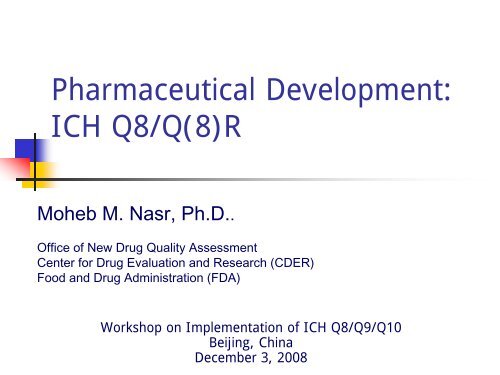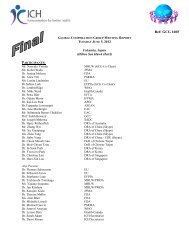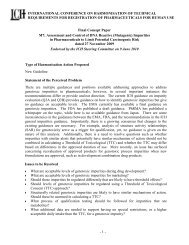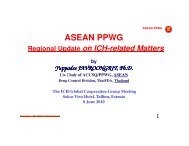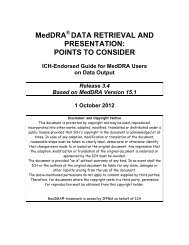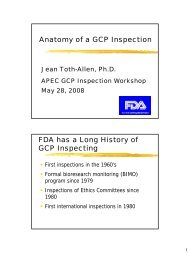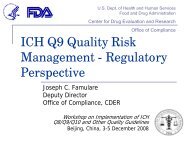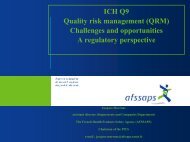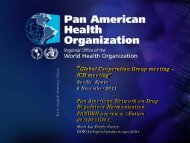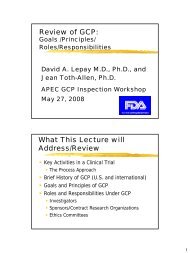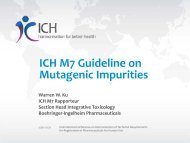Pharmaceutical Development: ICH Q8/Q(8)R
Pharmaceutical Development: ICH Q8/Q(8)R
Pharmaceutical Development: ICH Q8/Q(8)R
Create successful ePaper yourself
Turn your PDF publications into a flip-book with our unique Google optimized e-Paper software.
<strong>Pharmaceutical</strong> <strong>Development</strong>:<br />
<strong>ICH</strong> <strong>Q8</strong>/Q(8)R<br />
Moheb M. Nasr, Ph.D..<br />
Office of New Drug Quality Assessment<br />
Center for Drug Evaluation and Research (CDER)<br />
Food and Drug Administration (FDA)<br />
Workshop on Implementation of <strong>ICH</strong> <strong>Q8</strong>/Q9/Q10<br />
Beijing, China<br />
December 3, 2008
Outline<br />
• Recent <strong>ICH</strong> and FDA Guidances<br />
• <strong>ICH</strong> <strong>Q8</strong> and <strong>Q8</strong>(R)<br />
• Quality by Design (QbD)<br />
• Example Approach to QbD<br />
• QbD for APIs<br />
• FDA Experience with QbD<br />
• ONDQA QbD Pilot Program<br />
• Challenges of Implementing QbD<br />
• Concluding Remarks<br />
2
Recent <strong>ICH</strong> & FDA Guidances<br />
Product<br />
Design<br />
Process<br />
Design<br />
Manufacturing<br />
Process<br />
Monitoring/<br />
Continuous<br />
Verification<br />
<strong>ICH</strong> <strong>Q8</strong>/<strong>Q8</strong>(R) - <strong>Pharmaceutical</strong> <strong>Development</strong><br />
FDA PAT Guidance<br />
<strong>ICH</strong> Q9 – Quality Risk Management<br />
<strong>ICH</strong> Q10 – <strong>Pharmaceutical</strong> Quality Systems<br />
3
<strong>ICH</strong> <strong>Q8</strong> Guidance<br />
• Provides guidance on the contents of Section<br />
3.2.P.2 (<strong>Pharmaceutical</strong> <strong>Development</strong>)<br />
• Describes good practices for pharmaceutical<br />
product development<br />
• Introduces concepts of<br />
• Design space<br />
• Flexible regulatory approaches<br />
• Quality Risk Management (Q9)<br />
• Does not discuss QbD<br />
4
QbD Definition (<strong>ICH</strong> <strong>Q8</strong>(R))<br />
A systematic approach to development<br />
that begins with predefined objectives<br />
and emphasizes product and process<br />
understanding and process control,<br />
based on sound science and quality risk<br />
management<br />
5
Why QbD?<br />
• Higher level of assurance of product quality<br />
• Cost saving and efficiency for industry<br />
• Increase efficiency of manufacturing process<br />
• Minimize/eliminate potential compliance actions<br />
• Provide opportunities for continual improvement<br />
• Facilitate innovation<br />
• More efficient regulatory oversight<br />
• Enhance opportunities for first cycle approval<br />
• Streamline post approval manufacturing changes and<br />
regulatory processes<br />
• More focused PAI and post approval cGMP inspections<br />
6
<strong>ICH</strong> <strong>Q8</strong>R<br />
• Annex to <strong>ICH</strong> <strong>Q8</strong><br />
• Describes principles of QbD vs. minimal<br />
approach<br />
• Provides further clarification of key<br />
concepts of <strong>Q8</strong><br />
• Provides illustrative examples<br />
• Details provided in the next<br />
Presentation -Brian Withers, Abbott<br />
Laboratories<br />
7
<strong>ICH</strong> <strong>Q8</strong>(R) Update<br />
• Reached Step 4 in Brussels, November 11,<br />
2008<br />
• Only a few minor step 4 revisions:<br />
• Quality Target product Profile<br />
• QTPP forms the basis of design for development<br />
• Design space versus proven acceptable ranges<br />
• combination of PARs doesn’t constitute design space<br />
• Real Time Release Testing (RTRT)<br />
• To distinguish between RTRT and batch release<br />
8
<strong>ICH</strong> Q9 and Q10<br />
• Key enablers<br />
• Assure correct implementation of<br />
QbD (<strong>Development</strong> &<br />
manufacturing throughout product<br />
life cycle and supply chain)<br />
• Both will be discussed in more<br />
details tomorrow<br />
9
<strong>ICH</strong> Q9: Quality Risk Management<br />
• A systematic process for the assessment,<br />
control, communication and review of risks<br />
to the quality of the drug product<br />
• Guidance includes principles and examples<br />
of tools for quality risk management<br />
• Evaluation of risk to quality should:<br />
• be based on scientific knowledge<br />
• link to the protection of the patient<br />
• Applies over product lifecycle: development,<br />
manufacturing and distribution<br />
10
Quality Risk Management Process<br />
Process<br />
<strong>Development</strong><br />
Control Strategy<br />
<strong>Development</strong><br />
Continual<br />
Improvement<br />
11
Role of Quality Risk Management in<br />
<strong>Development</strong> & Manufacturing<br />
Product<br />
<strong>Development</strong><br />
Process<br />
<strong>Development</strong><br />
Process Scale-up<br />
& Tech Transfer<br />
Manufacturing<br />
Product/prior<br />
Knowledge<br />
Process<br />
Understanding<br />
Process<br />
History<br />
Risk<br />
Assessment<br />
Risk<br />
Assessment<br />
Risk<br />
Control<br />
Risk<br />
Review<br />
Excipient &<br />
drug substance<br />
design space<br />
Process<br />
design space<br />
Product quality<br />
control strategy<br />
Continual<br />
improvement<br />
Quality Risk Management<br />
12
<strong>ICH</strong> Q 10: Why Focus on PQS?<br />
• The regulatory flexibility provided with a<br />
design space approach requires effective<br />
change management at the manufacturing<br />
site<br />
• Track and trend product quality<br />
• Respond to process trends before they become<br />
problems<br />
• Maintain and update models as needed<br />
• Internally verify that process changes are<br />
successful<br />
13
Example QbD Approach (<strong>ICH</strong> <strong>Q8</strong>R)<br />
QTPP<br />
CQAs<br />
Risk<br />
assessment<br />
Design<br />
space<br />
Control<br />
strategy<br />
Continual<br />
Improvement<br />
• Target the product profile<br />
• Determine critical quality attributes (CQAs)<br />
• Link raw material attributes and process<br />
parameters to CQAs and perform risk<br />
assessment<br />
• Develop a design space<br />
• Design and implement a control strategy<br />
• Manage product lifecycle, including<br />
continual improvement<br />
14
Product<br />
profile<br />
CQAs<br />
Risk<br />
assessment<br />
Design<br />
space<br />
Control<br />
strategy<br />
Continual<br />
Improvement<br />
Quality Target Product Profile<br />
“Begin with the end in mind”<br />
• Summary of the quality<br />
characteristics of a drug product<br />
to ensure safety and efficacy<br />
• Includes, but not limited to:<br />
• Dosage form<br />
• Route of administration<br />
• Pharmacokinetic characteristics<br />
• e.g., dissolution, aerodynamic performance<br />
• Quality characteristics for intended use<br />
• e.g., sterility, purity<br />
15
Critical Quality Attributes (CQAs)<br />
Product<br />
profile<br />
CQAs<br />
Risk<br />
assessment<br />
Design<br />
space<br />
Control<br />
strategy<br />
Continual<br />
Improvement<br />
• Physical, chemical, biological or<br />
microbiological property or characteristic<br />
• Drug product, drug substance,<br />
intermediates, and excipients can possess<br />
CQAs<br />
• Directly affect product quality<br />
• Affect downstream processability<br />
• Drug product CQAs affect product quality,<br />
safety, and/or efficacy<br />
• Attributes describing product purity, potency,<br />
stability and release<br />
• Additional product specific aspects (e.g.,<br />
adhesive force for transdermal patches)<br />
16
Risk Assessment (<strong>ICH</strong> Q9)<br />
Product<br />
profile<br />
CQAs<br />
Risk<br />
assessment<br />
Design<br />
space<br />
Control<br />
strategy<br />
Continual<br />
Improvement<br />
• Tools for parameter screening<br />
• Examples: Ishikawa diagrams, What-if analysis,<br />
HAZOP analysis<br />
• Tools for risk ranking<br />
• Examples: FMEA/FMECA, Pareto analysis,<br />
Relative ranking<br />
• Experimental tools for process<br />
understanding<br />
• Examples: Statistically designed experiments<br />
(DOE), mechanistic models<br />
17
Design Space (<strong>ICH</strong> <strong>Q8</strong>)<br />
Product<br />
profile<br />
CQAs<br />
Risk<br />
assessment<br />
Design<br />
space<br />
Control<br />
strategy<br />
Continual<br />
Improvement<br />
• Definition<br />
• The multidimensional combination and<br />
interaction off input variables (e.g., material<br />
attributes) and process parameters that have<br />
been demonstrated to provide assurance of<br />
quality<br />
• Regulatory flexibility<br />
• Working within the design space is not<br />
considered a change<br />
• Important to note<br />
• Design space is proposed by the applicant and<br />
is subject to regulatory assessment and<br />
approval<br />
18
Design Space Determination<br />
• First-principles approach<br />
• combination of experimental data and mechanistic<br />
knowledge of chemistry, physics, and engineering to<br />
model and predict performance<br />
• Non-mechanistic/empirical approach<br />
• statistically designed experiments (DOEs)<br />
• linear and multiple-linear regression<br />
• Scale-up correlations<br />
• translate operating conditions between different scales<br />
or pieces of equipment<br />
• Risk Analysis<br />
• determine significance of effects<br />
• Any combination of the above<br />
19
Describing Design Spaces<br />
• Linear Ranges of Parameters<br />
• Mathematical Relationships<br />
• Time-dependent functions<br />
• Combinations of variables<br />
• e.g., Principle components of multivariate<br />
model<br />
• Scaling Factors<br />
• Single or multiple unit operations<br />
The applicant decides how to describe<br />
and present the design space<br />
20
Design Spaces Example #1<br />
Surface Plot<br />
Contour Plot<br />
100.0<br />
2<br />
Dissolution (%)<br />
95.0<br />
90.0<br />
85.0<br />
80.0<br />
75.0<br />
70.0<br />
65.0<br />
60.0<br />
55.0<br />
50.0<br />
40<br />
Parameter 1<br />
50<br />
60 0<br />
1<br />
2<br />
Parameter 2<br />
Design Space<br />
(linear ranges)<br />
Design Space<br />
(non-linear)<br />
0<br />
40 42 44 46 48 50 52 54 56 58 60<br />
Parameter 1<br />
1.8<br />
1.6<br />
1.4<br />
1.2<br />
1<br />
0.8<br />
0.6<br />
0.4<br />
0.2<br />
Parameter 2<br />
Dissolution (%)<br />
90.0-95.0<br />
85.0-90.0<br />
80.0-85.0<br />
75.0-80.0<br />
70.0-75.0<br />
65.0-70.0<br />
60.0-65.0<br />
• Design space can be described as a mathematical function or<br />
simple parameter range<br />
• Operation within design space will result in a product meeting the<br />
defined quality attributes<br />
21
Design Spaces Example #2<br />
Dissolution<br />
2<br />
1.8<br />
Design space for multiple attributes<br />
Dissolution<br />
Design<br />
Space<br />
0<br />
40 42 44 46 48 50 52 54 56 58 60<br />
Parameter 1<br />
Friability<br />
1.6<br />
1.4<br />
1.2<br />
1<br />
0.8<br />
0.6<br />
0.4<br />
0.2<br />
Parameter 2<br />
Dissolution (%)<br />
90.0-95.0<br />
85.0-90.0<br />
80.0-85.0<br />
75.0-80.0<br />
70.0-75.0<br />
65.0-70.0<br />
60.0-65.0<br />
Parameter 2<br />
2.0<br />
1.0<br />
Combined<br />
Design<br />
Space<br />
2<br />
Friability<br />
Design<br />
Space<br />
1<br />
Parameter 2<br />
Friability (%)<br />
4.0-5.0<br />
3.0-4.0<br />
2.0-3.0<br />
1.0-2.0<br />
0.0-1.0<br />
0.0<br />
40 50 60<br />
Parameter 1<br />
0<br />
40 50 60<br />
Parameter 1<br />
22
Quality Control Strategy<br />
Product<br />
profile<br />
Process<br />
understanding<br />
(incl. design space)<br />
CQAs<br />
Risk<br />
assessment<br />
Design<br />
space<br />
Control<br />
strategy<br />
Process<br />
controls<br />
Quality<br />
Control<br />
Strategy<br />
Specifications<br />
(raw materials,<br />
Intermediates, product)<br />
Continual<br />
Improvement<br />
Quality control strategy encompasses process controls and<br />
specifications, based on process understanding
Continual Improvement<br />
Product<br />
profile<br />
CQAs<br />
Risk<br />
assessment<br />
Design<br />
space<br />
Control<br />
strategy<br />
Continual<br />
Improvement<br />
• Flexibility for movement within design space<br />
• Wider range of material attributes or process<br />
parameters<br />
• No reporting if moving operating range within<br />
design space<br />
• Potential scale or equipment change without<br />
supplement (subject to regional regulatory<br />
requirements)<br />
• Post-Approval Management Plan (CMC-PMP)<br />
• A mechanism for applicant to propose a<br />
regulatory strategy specific to a product and/or<br />
process<br />
• Currently under development by FDA<br />
24
QbD Concepts in <strong>Development</strong> and<br />
Manufacturing of API<br />
• It may be simpler to apply QbD concepts to<br />
drug substances than drug product<br />
• Mixing and transport within liquids and slurries<br />
better understood than for dry particles<br />
• Well-established modeling techniques<br />
• Reaction kinetics<br />
• Cell growth<br />
• Crystallization nucleation and growth<br />
• Scale-up correlations<br />
• Readily available in-line and on-line<br />
measurement techniques<br />
• Laboratory equipment for parallel experiments<br />
and automated analysis<br />
25
Example Risk Assessment for<br />
Batch API Synthesis Step<br />
Category<br />
Crystallizati<br />
on<br />
Filtration<br />
Drying<br />
Process<br />
Parameter<br />
Residual solvent<br />
level<br />
Severit<br />
y<br />
S (1-5)<br />
Occurren<br />
ce<br />
O (1-5)<br />
Detectio<br />
n<br />
D (1-5)<br />
Risk<br />
priority<br />
numbe<br />
r<br />
S*O*D<br />
Risk<br />
Ranking/Prioritizati<br />
on<br />
5 4 3 60 1<br />
Nucleation time 4 3 2 24 6<br />
Anti-solvent<br />
addition rate<br />
5 3 2 30 4<br />
Agitation rate 4 2 1 8 11<br />
Seed amount 4 4 2 32 3<br />
Hold time 2 1 1 2 15<br />
Agitation rate 5 2 3 30 4<br />
Wash step 3 1 1 3 13<br />
Agitation rate 5 3 3 45 2<br />
Temperature 4 2 3 24 6<br />
Risk ranking helps focus research and development efforts
ONDQA’s QbD Pilot Program<br />
• Objectives<br />
• To provide participating firms an opportunity to submit<br />
CMC information demonstrating QbD<br />
• To enable FDA to implement new QbD concepts<br />
• Status<br />
• 9 original and 3 supplemental NDAs accepted<br />
• 11 submitted to date: 9 approved, 2 under review<br />
• Common factors<br />
• Submission of design space<br />
• Use of risk assessment<br />
• Proposals of regulatory flexibility under firm’s quality system<br />
27
Examples of Design Space<br />
in Recent NDAs<br />
• Excipient attributes<br />
• Degree of polymer substitution<br />
• Viscosity/molecular weight distribution<br />
• Particle size distribution<br />
• Drug substance attributes<br />
• Particle size distribution<br />
• Process parameters<br />
• Drug substance unit operations<br />
• Drug product unit operations<br />
• Effect of scale-up considered<br />
• Effect of equipment type understood<br />
28
CMC Pilot Program –<br />
Design Space Observations<br />
• Most applications included a design space for drug<br />
product; some for drug substance<br />
• Most included design spaces for process<br />
parameters; some included formulation<br />
component properties<br />
• Methods for determining design space included:<br />
• One variable at a time experiments<br />
• Statistically designed experiments (DOE’s)<br />
• Modeling approaches<br />
29
CMC Pilot Program –<br />
Control Strategy Examples<br />
• Certain tests for drug substance CQAs moved<br />
upstream to the control points<br />
• On-line analyzers (non-PAT) used for<br />
intermediates<br />
• In-process testing (in lieu of end-product<br />
testing) for<br />
• Identification and assay using at-line NIR<br />
• Dose uniformity by on-line weight variation<br />
• Real-time release testing<br />
30
CMC Pilot Program –<br />
Risk Assessment Observations<br />
• Several applications presented risk<br />
assessments<br />
• Linking of process parameters to CQAs<br />
• Identification of relevant parameters for design<br />
space<br />
• Weighting of processing risks and experimental<br />
priorities<br />
• Tools used included Ishikawa (fishbone)<br />
diagrams, FMEA analysis, Pareto analysis<br />
31
Findings from ONDQA Pilot Program<br />
• Provided valuable experience for industry and FDA<br />
in implementing QbD<br />
• Elements of QbD in submissions<br />
• Risk assessments<br />
• Design spaces<br />
• Proposals for flexible regulatory approaches<br />
• Risk-based regulatory decisions were enabled<br />
• Pointed out gaps<br />
• Learning from pilot applied to <strong>ICH</strong> <strong>Q8</strong> (R)<br />
• Demonstrated the need for:<br />
• Harmonized implementation (<strong>ICH</strong> IWG)<br />
• Post-Approval Management Plan (CMC-PMP)<br />
32
Challenges of Implementing QbD<br />
• FDA<br />
• Communicating new concepts<br />
• Providing regulatory flexibility while assuring product quality<br />
• Integration of review and inspection under the new <strong>ICH</strong> quality<br />
paradigm<br />
• Industry<br />
• Management support<br />
• Communication across business units<br />
• Global acceptance and implementation<br />
• FDA and industry<br />
• Cultural changes needed<br />
• More resources needed initially (Investment)<br />
• Learning and experience needed for new approaches<br />
33
Concluding Remarks<br />
• Quality by Design has moved into the<br />
implementation phase<br />
• New guidelines are in place to facilitate<br />
• Recent NDAs (incl. ONDQA pilot program) have<br />
provided opportunities for implementing QbD<br />
• Full implementation of QbD is a win-win-win<br />
situation<br />
• Manufacturers – Better understanding of<br />
product/process, more efficient process, reduced<br />
regulatory burden<br />
• Regulators – providing regulatory flexibility without<br />
sacrificing quality<br />
• Patients – increased assurance of product quality<br />
34
Pathway to the Desired State<br />
The Desired State:<br />
A maximally efficient, agile, flexible<br />
pharmaceutical manufacturing sector that<br />
reliably produces high-quality drug products<br />
without extensive regulatory oversight.<br />
The Desired<br />
State<br />
Quality Risk Management<br />
(<strong>ICH</strong> Q9)<br />
Quality by Design Highway<br />
Current<br />
State<br />
QbD<br />
Product and Process<br />
Understanding<br />
(<strong>ICH</strong> <strong>Q8</strong>/<strong>Q8</strong>R))<br />
<strong>Pharmaceutical</strong><br />
Quality Systems<br />
(<strong>ICH</strong> Q10)<br />
35


